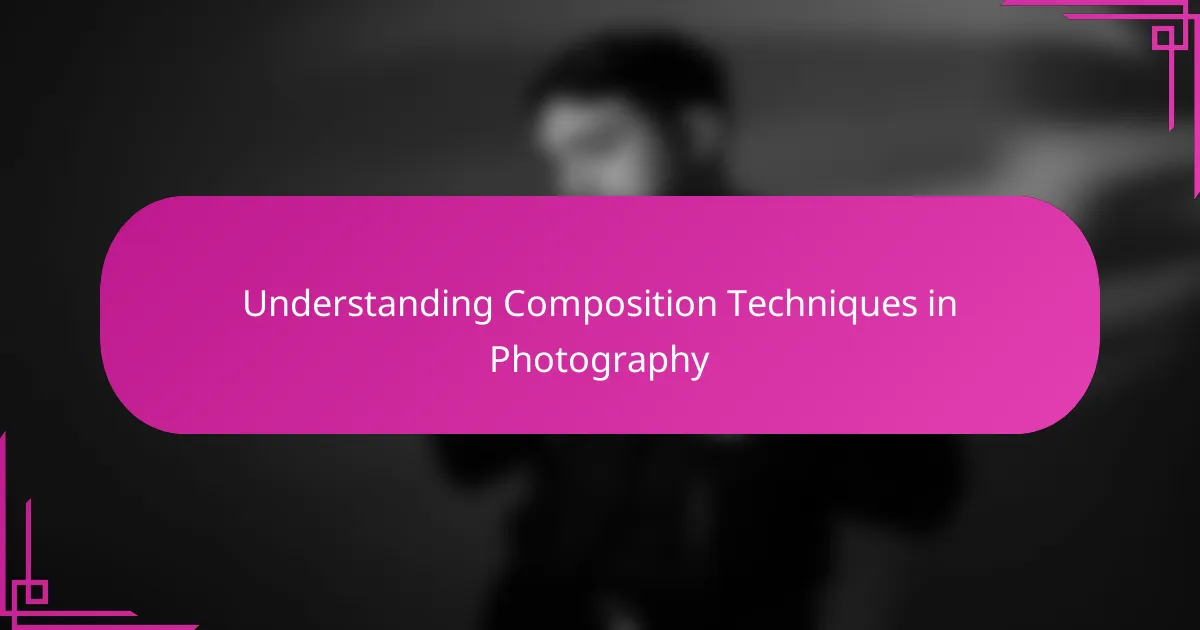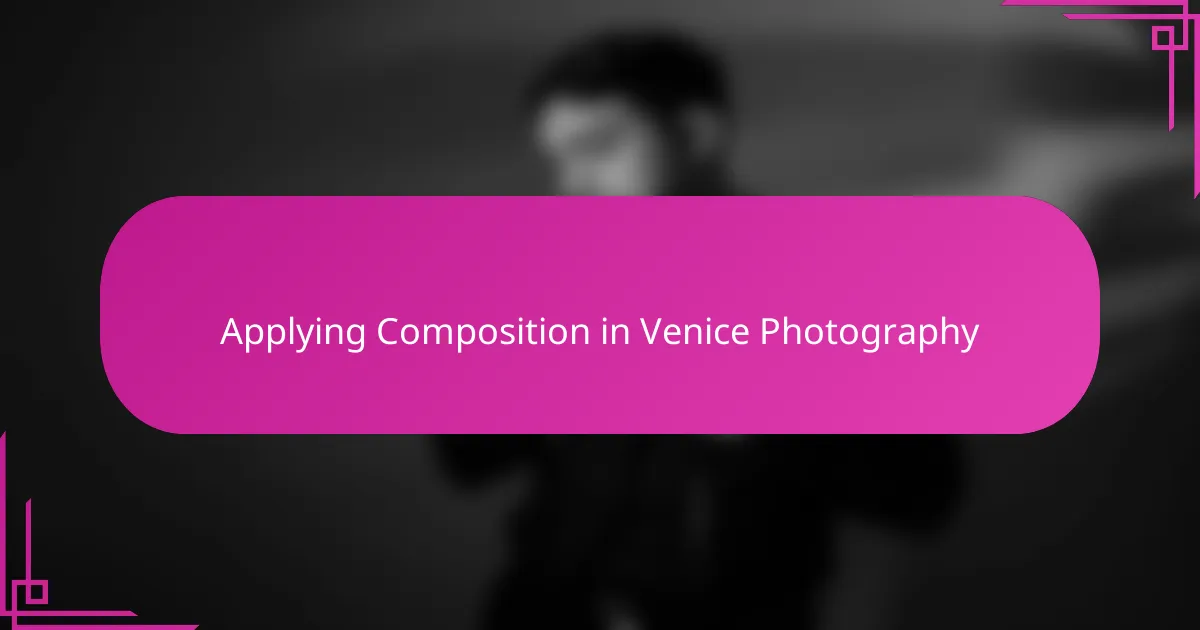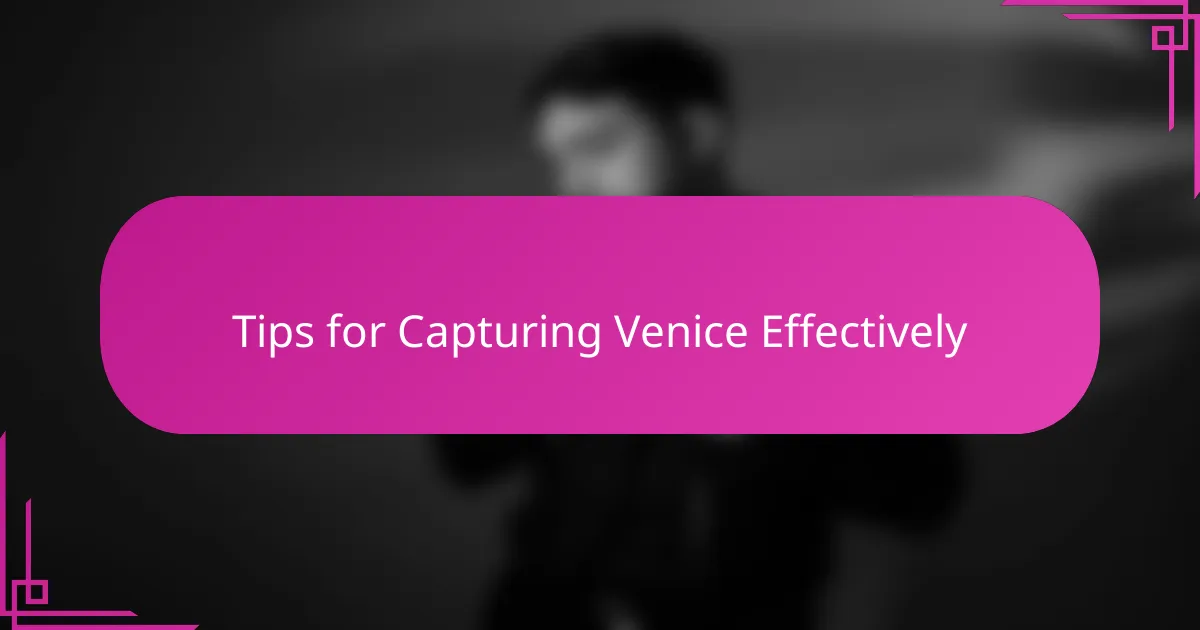Key takeaways
- The rule of thirds enhances photos by creating balance and tension, making images feel more dynamic.
- Leading lines and natural framing in Venice guide viewers’ eyes, adding depth and inviting exploration.
- Capturing both detail and context is essential for storytelling in photography, particularly in busy environments.
- Embracing patience and varying perspectives can unlock new compositions and memorable moments.

Understanding Composition Techniques in Photography
Composition techniques in photography are more than just rules—they’re my way of seeing the world differently. When I first explored them, I realized how arranging elements thoughtfully can transform a simple snapshot into a compelling story. Have you ever looked at a photo and felt drawn into its scene without knowing exactly why? That’s the magic of good composition.
One technique I find myself returning to is the rule of thirds. It’s surprisingly simple but incredibly powerful. Placing key elements off-center creates balance and tension, making images feel more natural and dynamic. I remember capturing a gondolier framed this way in Venice; the photo instantly felt alive, as if I was right there on the water with him.
But beyond rules, I think composition is about emotional connection—how different angles, lines, and frames can evoke a mood or memory. For me, it’s almost like a silent conversation with the viewer, guiding their eyes and feelings. What does your composition say about the story you want to tell?

Key Composition Rules for Stunning Photos
One key rule I always keep in mind is leading lines. In Venice, the canals and narrow alleys naturally form lines that draw your eye deeper into the frame. When I followed those lines with my lens, the photos felt like invitations to step inside another world. Have you noticed how a well-placed line can guide your gaze effortlessly through a scene?
Another essential rule for me is balancing elements. It’s not just about symmetry but about creating harmony between subjects and empty space. I once shot the colorful buildings reflecting on the water, balancing the vibrant hues against calm areas where the ripples softened the view. That balance made the image feel peaceful yet full of life.
Finally, I can’t overlook framing. Venice offers so many natural frames—arched bridges or window openings—that give photos depth and context. I recall capturing a street musician framed by a doorway; it was like I was sharing a secret moment with the viewer. Don’t you think framing adds an intimate layer to storytelling through photos?

Applying Composition in Venice Photography
When I apply composition techniques in Venice, I always look for those moments where the city’s unique geometry meets its vibrant life. For instance, I found a quiet corner where the ripples of a canal reflected colorful facades—by carefully placing these reflections using the rule of thirds, the photo felt both balanced and alive, almost like capturing Venice’s heartbeat in a frame.
I also love using Venice’s winding canals as natural leading lines, guiding the viewer’s eye through the maze of waterways. In one shot, I followed a canal that curved gently beneath a bridge, creating a visual path that pulled me right into the scene. It’s moments like these that remind me how composition in Venice isn’t just about aesthetics—it’s about inviting someone to explore the city with me, step by step.
Framing in Venice often surprises me with its intimacy. A narrow archway or a window isn’t just a boundary; it becomes a portal into a secret world. I once captured an elderly fisherman through a small arch, and the frame made the image feel like a delicate whisper of daily life, encouraging viewers to pause and connect with the story behind the lens. Don’t you find those hidden frames almost magical?

Exploring Unique Venetian Scenes
Venice is a treasure trove of unique scenes that seem to whisper stories at every turn. I remember wandering through a quiet campo where vibrant laundry fluttered between ancient buildings, and the way the soft light hit those fabrics felt like capturing a fleeting secret of daily life. Have you ever stumbled upon a moment so simple yet so evocative that it stays with you long after?
What fascinates me most is how Venice’s layering of history and daily rhythm creates compositions charged with contrast. One afternoon, I found myself drawn to a weathered wall adorned with faded posters, juxtaposed against a sleek gondola gliding silently by. That unexpected pairing made me pause and think—how often do we overlook such poetic collisions in our photos?
Exploring Venice means constantly seeking those offbeat angles that reveal the city’s soul beyond the usual postcard views. I often try to catch reflections in less obvious canals, where distorted water surfaces play with colors and shapes in unpredictable ways. Isn’t it thrilling when a composition surprises you, inviting you to see Venice anew?

Personal Insights on Composition Challenges
Composition in Venice presents unique challenges that often push me out of my comfort zone. For example, the abundance of reflective water surfaces can create confusing visual noise, making it hard to decide what to emphasize. Have you ever struggled to balance such busy elements without the photo feeling cluttered? I’ve found that patience and sometimes waiting for just the right light or moment help me simplify these complex scenes.
Another challenge I often face is capturing the intimate atmosphere of narrow Venetian alleys without losing spatial context. It’s tempting to zoom in on textures or details but then the story might feel incomplete. I’ve learned to step back occasionally, allowing the framing to include hints of the surrounding environment, which adds depth and invites the viewer to explore further. Isn’t finding that sweet spot between detail and context the real art of composition?
Finally, Venice’s constant movement—boats, people, shifting light—makes timing as important as placement. I recall attempting a shot where a gondola entered the frame just as golden hour light kissed the buildings. It felt like catching a fleeting moment of harmony, yet the unpredictability of the scene kept me alert and adaptable. Do you find that in such dynamic settings, your composition becomes more about anticipating change than rigid structure? That’s something I’m still learning to embrace.

Tips for Capturing Venice Effectively
One tip I always emphasize is to embrace Venice’s slow pace. Instead of rushing from one iconic spot to another, I find that lingering in one place lets me notice subtle shifts in light and shadow. Have you ever waited patiently by a canal only to catch that perfect moment when the fading light dances on the water? Those pauses often make the difference between a snapshot and a memorable image.
Another practical approach is to look up and down. Venice is full of intricate details—whether it’s the ornate balconies overhead or the textured reflections on the canal surface. I remember tilting my camera downward to capture ripples casting distorted shapes of a historic façade, creating a layered composition that tells more than one story at once. Do you find that varying your perspective unlocks new ways to engage with familiar scenes?
Lastly, I’ve learned the value of working with natural frames, not just archways but even the shadows they cast. During one early morning shoot, I used a bridge’s silhouette to encase a lone boat drifting quietly, and it felt like framing a whispered secret. Have you ever noticed how these organic frames add intimacy, almost inviting the viewer into a hidden, personal moment?